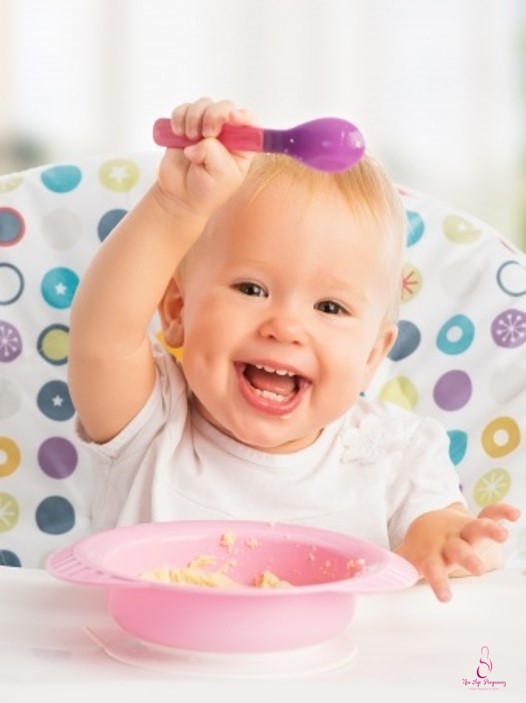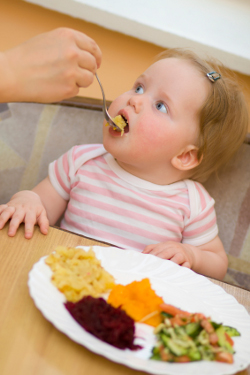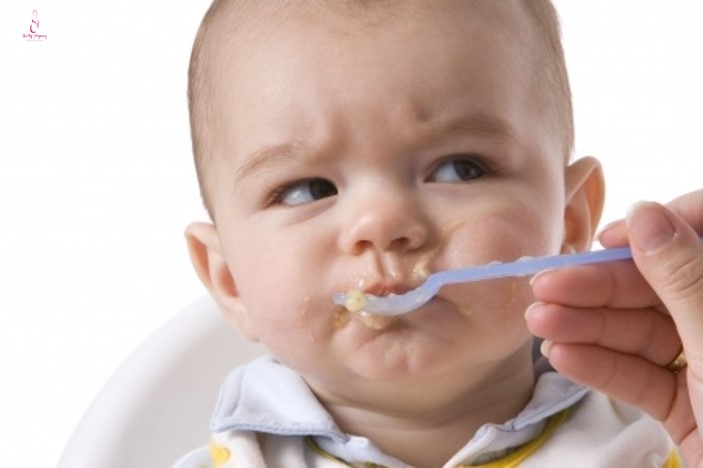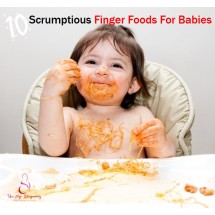
Introducing solids to babies has traditionally been using pureed foods or rice cereals. However, there is another approach known as baby-led weaning (BLW). Baby-led weaning is letting your baby feed himself from the start, without going through the stage of preparing pureed foods and spoon-feeding.
Baby-led Weaning – How does it work?
Baby-led weaning can be introduced at around six months old, when the baby is able to sit up straight. Choose a time when the baby can sit at the table (on his high chair or on an adult’s lap) with the rest of the family and able to handle food. Suitable finger foods are presented in front of the baby and these foods should be cooked, soft and easy for the baby to grip. The baby may then be interested and explore the colorful foods presented, so be sure to have his bib on and possibly, lay some plastic sheet under the chair for easier clean-up. It is then up to the baby to explore the foods and put the foods in his mouth. Water can also be offered in a small cup.
Signs of Baby’s Readiness
Generally, six months is an ideal time for solid foods, regardless of the approach to introduce solids foods. It is about the age where the baby is:
– Able to sit up right without support
– Able to reach out and grab things
– Able to direct objects into the mouth
– Able to move foods around the mouth and take the food to the back of mouth
– Able to have enough energy or interest to feed himself
– Able to digest most solid foods, i.e. the gastrointestinal and immune systems are able to cope with foods other than milk
Safety and Precautions
There are a few points to note when using baby-led weaning approach:
#1 No choking hazard
The foods you present for your baby to try feeding himself should be soft, easy to chew but also able to be grip. For instance, cooked broccoli, cooked carrots, bananas and not small, hard foods like nuts or grapes.
#2 Adult supervision
Adults should always be around to supervise and to encourage. Similar to encouraging your baby to take his first step, babies need to be encouraged but not forced in baby-led weaning.
#3 Not Adult-Led
Apart from going against the purpose of baby-led weaning, adults placing solid foods in the baby’s mouth can potentially be dangerous. If foods fall out of the baby’s mouth, it is possible that he has not mastered the muscular control needed to bring these foods to the back of mouth and swallow. As such, the foods fall out. By placing the foods into his mouth, it can cause choking as your baby may not be ready to swallow the food.
Gagging is common in the early stages of baby-led weaning. It is to prevent foods that are not chewed adequately to go too far back. This is different from choking and once the baby is more skilled at chewing, gagging will be less frequent.
Advantages and Disadvantages of BLW
The advantages of BLW, largely based on parents’ observations include:
Advantage #1 Open to trying foods
The idea is that since the baby has learnt to explore foods from the start, he will be more open to trying new foods. This can potentially avoid picky-eating and make it more enjoyable as there will then be more options at family meals that everyone can enjoy.
Advantage #2 No special foods required
The baby shares the same foods that the family is eating; however, care should be taken that these are not choking hazards nor too hard.
Advantage #3 Wholesome foods
The foods are prepared at home and not jarred baby foods or rice cereals (which may have a higher sugar content).
Advantage #4 Improved dexterity
With so much practice in holding, gripping and eventually pinching food, placing food in the mouth, chewing and swallowing the foods, babies who lead their own weaning possibly develop motor skills sooner.
There are also disadvantages with BLW, such as:
Disadvantage #1 Nutritional deficiency
The concern is that when the baby starts solids, it is also about the time when he needs additional iron. This can be a bit challenging to come directly from whole foods. Also, monitor how much solids your baby actually eats and be sure to include adequate milk in his diet.
Disadvantage #2 Choking hazard
This can largely be avoided by not serving small, hard foods and supervising your baby whenever he is putting things in his mouth.
Disadvantage #3 Messy
It can get messy in the early stages when foods fall out of the mouth and onto the baby or the floor. To some extent, it is also wasteful.
Baby-led weaning is not suitable for all babies, especially if your baby has special needs and have difficulty with the motor skills required. Premature babies may need more assistance with feeding, so do check with the pediatrician.
By Mei






